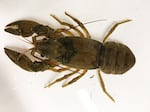
The Northern crayfish can be identified by the barnacle-like bumps on its claws. Color can't be used to distinguish crayfish species.
Michael Parker
The Oregon Department of Fish and Wildlife says it’s gotten reports of the invasive Northern crayfish found in the Ashland Canal. This species is native to the Midwest, but has also been found in California and Washington.
Rick Boatner with the Oregon Department of Fish and Wildlife suspects the crayfish were introduced by a school group or pet owner who dumped them into the canal. He says these crayfish will compete with native species for the same habitat.
“It’d be similar to in the 80s [when] Rusty crayfish got released into the John Day river system,” he says. “And now they’re the dominant crayfish species in the John Day Basin.”
Northern crayfish are more aggressive than others and could end up eating endangered salmon and steelhead eggs.
ODFW is now working on identifying their range so they can figure out how to trap them.
“I’m not super confident that we’d get them all that way,” Boatner says. “Granted it will control them, but if we say we completely eradicate them, that’s kind of a different story.”
ODFW will have to work with landowners along the canal to allow them to survey and trap the crayfish. Boatner says they can’t use poison to kill the crayfish, since the canal feeds into the Bear Creek, a tributary of the Rogue River.
The canal does dry up for most of the year. Boatner says he’s optimistic that will help keep them from spreading. But crayfish are resilient. They can burrow into mud to wait for water or even walk across land to find another body of water.
Boatner says his organization does outreach with schools to try and avoid introduction of invasive species. Schools and individuals can face penalties or civil fines for releasing invasive species and importing non-native crayfish to Oregon requires a permit.
Anyone who spots a possible invasive crayfish should take a clear, top-down picture and send it to the Oregon Invasive Hotline.
Boatner expects it may take several years to control or eradicate them, depending on how far they’ve already spread.